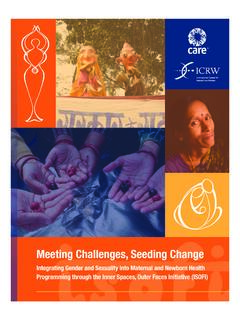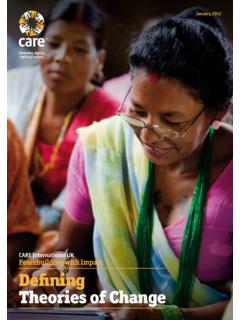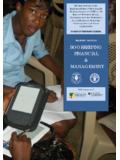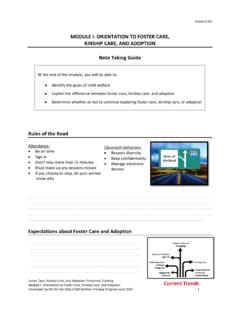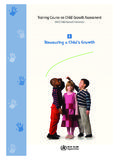Transcription of Module 4: Gender Training - CARE
1 CARE Gender , Equity, and Diversity Training Materials Module 4: Gender Training Copyright 2014 Cooperative for Assistance and Relief Everywhere, Inc. (CARE). All rights reserved. CARE grants permission to not for profit organizations engaged in humanitarian and development activities to reproduce this work, in whole or in part, for noncommercial purposes in connection with such activities. This work is not to be sold, rented, leased, or used for advertising or other promotional purposes without CARE s express written consent. As a condition to CARE granting permission to reproduce this work, the following notice shall appear conspicuously with any and all reproductions: CARE s Gender Equity and Diversity Training Materials.
2 Copyright 2014 Cooperative for Assistance and Relief Everywhere, Inc. (CARE). Used by Permission. Module FOURGENDER TRAININGThis Module provides Training tools to promote a better understanding of Gender within the organization. It also aims to build skills of participants in incorporating Gender in programming issues and our organizational activities and exercises are arranged in a way that encourages participants to go through a process, whereby they first reflect on their own personal experiences and observations. Then they link these reflections to what they see and observe in their programs. Therefore, the idea is to impart knowledge and skills, starting from a basic level and moving on to more complex and thought provoking Module has been designed based on the Indian context and primarily for CARE staff.
3 This Module can also be found as part of a recently published Gender manual for CARE India. 181 Note: Module Four has a Participant WorkbookSample AgendaThis is an illustrative agenda with estimated time-frames. You are encouraged to select the activities that most meet your I - ActivitiesWelcome and Introductions 9 am - 9:20 amGoals and outline of the Training 9:20 am - 9:30 amBeginning to understand Gender 9:30 am - 10 amGender division of articles, activities and roles10:00 am - 10:30 amBreakGender behaviors and their consequences10:45 am - 11:45 amGender Stereotypes11:45 am - 12:45 pmBreak12:45 pm - 1:30 pmConsequences of stereotypes1:30 pm - 2:15 pmPressures and privileges of being a woman/man 2:15 pm - 3:00 pmBreakSelf-disclosure of male/female roles 3:15 pm - 4:15 pmThe story of a queen and king 4:15 pm - 5:00 pmClosing and reflection on the day 5:00 pm - 5.
4 30 pmDay II - ActivitiesReflection on the previous day9 am - 9:20 amGender discrimination 9:20 am - 10 amUnderstanding Gender -based violence 10 am - 10:30 amBreakMyths about violence against women10:45 am - 11:45 amRole of culture and religion11:45 am - 12:45 pmBreakRole of institutions1:30 pm - 2:15 pmChanging Gender constructs 2:15 pm - 3:15 pmBreakThe Wheel of Equality 3:30 pm - 4:15 pmPersonal experiences of self-assertion4:15 pm - 5:00 pmClosing and reflection of the two days5:00 pm - 5:30 pmMODULE FOUR183 Table of ContentsSAMPLE AGENDA FOR ONE DAY 1: WELCOME AND 2: GOALS AND OUTLINE OF THE Training ..185 ACTIVITY 3: BEGINNING TO UNDERSTAND Gender : WHAT IS Gender ?
5 HOW IS IT DIFFERENT FROM SEX?..186 ACTIVITY 4: Gender DIVISION OF ARTICLES, ACTIVITIES AND 5: GENDERED BEHAVIOURS AND THEIR 6: Gender STEREOTYPES: FEMININE AND MASCULINE 7: CONSEQUENCES OF MALE/FEMALE 8: PRESSURES AND PRIVILEGES OF BEING A 9: SELF-DISCLOSURE OF MALE/FEMALE 10: THE STORY OF A QUEEN AND 11: Gender DISCRIMINATION: UNFOLDING PERSONAL STORIES AND EXPERIENCES OF Gender 12: UNDERSTANDING Gender -BASED 13: MYTHS ABOUT VIOLENCE AGAINST 14: UNDERSTANDING DISCRIMINATORY PRACTICES THAT ACCORD A SUBORDINATE STATUS TO WOMEN AND ITS LINKAGE TO 15:GENDERED INSTITUTIONS AND STRUCTURES: ROLE OF TRADITIONAL AND MODERN 16: ROLE OF CULTURE AND 17.
6 ROLE OF FORMAL EDUCATIONAL, POLITICAL, ECONOMIC AND DEVELOPMENT 18:CHANGING Gender CONSTRUCTS: CHANGING Gender STEREOTYPES AND 19: PERSONAL EXPERIENCES OF 20: THE WHEEL OF 2: Goals and Outline of the TrainingPurpose To outline the Training and share the goals. To convey the workshop schedule clearly - breaks, lunch, and closure timings. To ensure people are aware of administrative arrangements and other housekeeping the goals on prepared flip charts or the agenda of the Training with the participants. Each participant should be given a copy of the agenda. Ask them to review it briefly and ask for clarifications, if any. for volunteers to record the workshop sessions and give feedback at the end of the day to the facilitator.
7 In addition, ask for volunteers who could be the 'eyes' and 'ears' to report on the unofficial remarks and comments of the participants. They could play a key role in determining the level of interest and involvement of participants in the workshop. They could also highlight which sessions were not well received or understood fully by the participants. the workshop hand outs and review the logistics for the 's Tips If handouts are not possible, put the details of the logistics on the flip chart and review it with theparticipants. Goals:lPromote a better understanding of Gender within the organization; lBuild skills of participants in incorporating Gender in programming issues and our organizational practices.
8 TIME 10 Min 185 Activity 1: Welcome and IntroductionPurpose To welcome participants to the Training . To allow facilitators to introduce themselves and to get to know the participants to the Training and introduce yourself to the group. This should be kept verybrief since you will also participate in icebreakers and other exercises. You will have an opportunity to say more about yourself each participant to introduce his/her name by simply adding an adjective before their name that begins with the same letter, before they disclose the name of their organization and designation You can begin by introducing yourself in the manner that you want to participants to follow.
9 For example: I am serious Surinder. I work in X as a Training Coordinator. I am mischievous Meena. I work in Y as a Project Manager. I am lively Leena. I work in Z as a Technical Specialist. This can be done when seated, but becomes more fun and active if the participants are standing in a circle. Each participant moves into the circle while introducing himself/herself. Facilitator's Tips: There is no need for debriefing after this exercise. It can serve as a reference point for the remainder of the Training workshop. The participants will remember each other's amusing adjectives. Mostimportantly, an atmosphere of informality is established. TIME 20 Min 184 Module FOURMODULE the participants to decide which statement denotes characteristics/behaviors based on sex and which are socially constructed.
10 Request them to explain why they think 's TipsExplain to the group that these statements were meant only to generate a discussion around how society promotes images of men and women, which result in Gender biases and images. Also explain why understanding the difference between sex and Gender is critical for development work. It helps us understand that the cause of inequity between men and women is not their biological characteristics, but socially constructed attributes of men and women. However, make sure that you do not undermine the significance of biological differences between men and women and treat them as less significant. Some physical differences do require different treatment.

